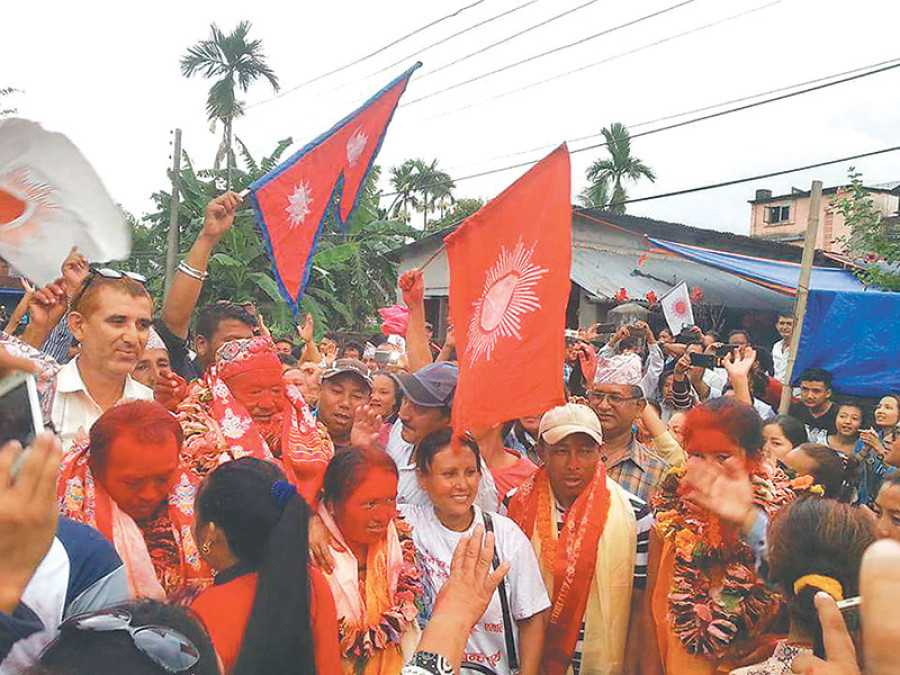Miscellaneous
Fringe parties limited to handful wins
With results of the second phase of local elections announced in more than two-thirds of the units in three provinces, fringe and regional parties have only a handful of local federal units in their share.
Tika R Pradhan
With results of the second phase of local elections announced in more than two-thirds of the units in three provinces, fringe and regional parties have only a handful of local federal units in their share. This, however, is a slight improvement over their performance in the first phase of local polls held on June 14.
The voting trend shows that three major parties will rule the roost, leaving little space for the regional and fringe parties. Naya Shakti Nepal, in alliance with the Sanghiya Samajbadi Forum-Nepal (SSF-N), Rastriya Prajatantra Party (RPP), Nepal Majdoor Kisan Party (NMKP) and Rastriya Janamorcha had won one local unit each in the first-phase vote held in 283 units of provinces 3, 4 and 6.
Though there are many deterrents for the small parties, experts believe it would be extremely difficult for the fringe and regional parties to snatch a respectable share of votes from the major parties in the first-past-the-post (FPTP) election system.
The vote leaves the Madhesi parties badly bruised with their leadership losing
command of the people, evidently in the results of the elections in provinces 1 and 5.
What helped them win the handful of top positions was not their organisational base or agendas but individual candidates’ popularity and caste-based support as seen in Nepalgunj sub-metropolis where the RPP’s Dhawal Shumsher Rana is leading with a huge margin. Madhes expert Tula Narayan Sah says the regional parties failed to garner votes because they failed to lead their movement to a logical conclusion. This has also caused their leadership to lose credibility.
“Why should Madhesi people vote for the losers?” Sah wondered. The people felt more secure with the major parties, he remarked.
However, SSF-N Co-chair Rajendra Shrestha said intra-party conflicts over whether or not to join the polls and inadequate time for publicity were some major reasons for the smaller forces’ poor results despite the alliances of some with one or the other major party.
Political analyst Krishna Khanal says the election results show that the
voting trend was largely power-oriented, in favour of the major parties having led governments.
“The only chance for the fringe parties to win was in their traditional pocket areas, as in the Rastriya Janamorcha’s win in Pyuthan, the NMKP’s in Bhaktapur Municipality and the Nepal Loktantrik Forum’s in Kailali,” said Khanal.
This is an indication that the fringe parties may not have much success in the FPTP system during national elections. That was largely the case in the second Constituent Assembly elections too.
Fringe parties’ win/leading so far
SSF-Nepal/Naya Shakti
Parvati Kunda Rural Municipality, Rasuwa (win)
Mayadevi Rural Municipality, Kapilvastu (win)
Gaidahawa Rural Municipality, Rupandehi (win)
Marchavari Rural Municipality, Rupandehi (win)
Rohini Rural Municipality, Rupandehi (win)
Bokraha Rural Municipality, Sunsari (win)
Narainapur Rural Municipality, Banke (win)
Nepal Loktantrik Forum
Duhabi Municipality, Sunsari (win)
Barju Rural Municipality, Sunsari (win)
Janaki Rural Municipality, Kailali (win)
Sarawal Rural Municipality, Nawalparasi (win)
Bhajani Municipality, Kailali (leading)
Rastriya Prajatantra Party
Ruby Valley Rural Municipality, Dhading (win)
Haldibari Rural Municipality, Jhapa, (win)
Kechanakawal Rural Municipality, Jhapa (win)
Nepalgunj Sub-metropolis (leading)
Rastriya Janamorcha
Bareng Rural Municipality, Baglung (win)
Mallarani Rural Municipality, Pyuthan (win)
Jhimruk Rural Municipality, Pyuthan (win)
Independent
Krishnanagar Municipality, Kapilvastu (leading)
Lumbini Sanskritik Municipality, Rupandehi
(leading)
Kotahimai Rural Municipality Rupandehi (leading)
Koshi Rural Municipality, Sunsari (leading)
Nepal Majdoor Kisan Party (NMKP)
Bhaktapur Municipality, Bhaktapur (win)




 14.12°C Kathmandu
14.12°C Kathmandu










